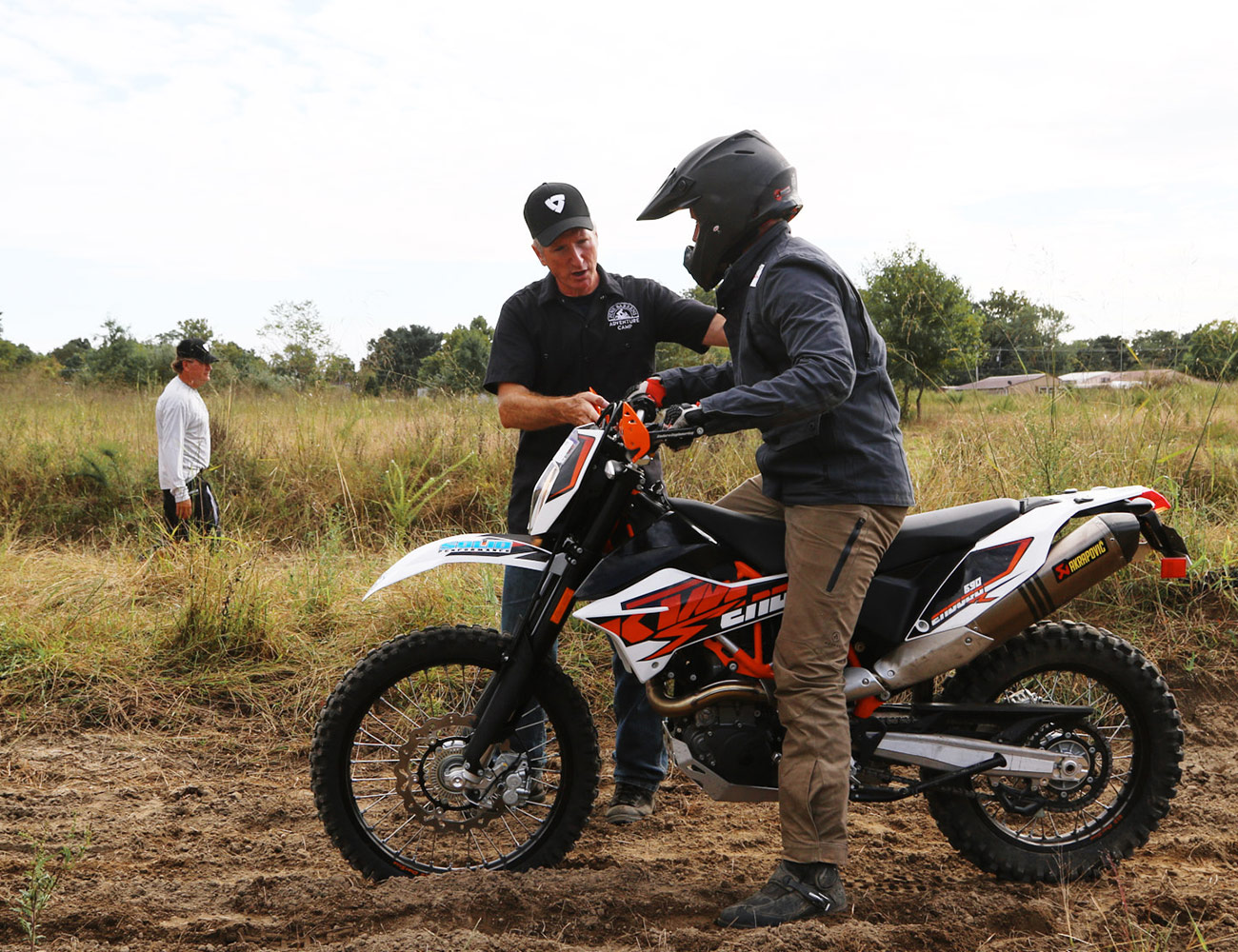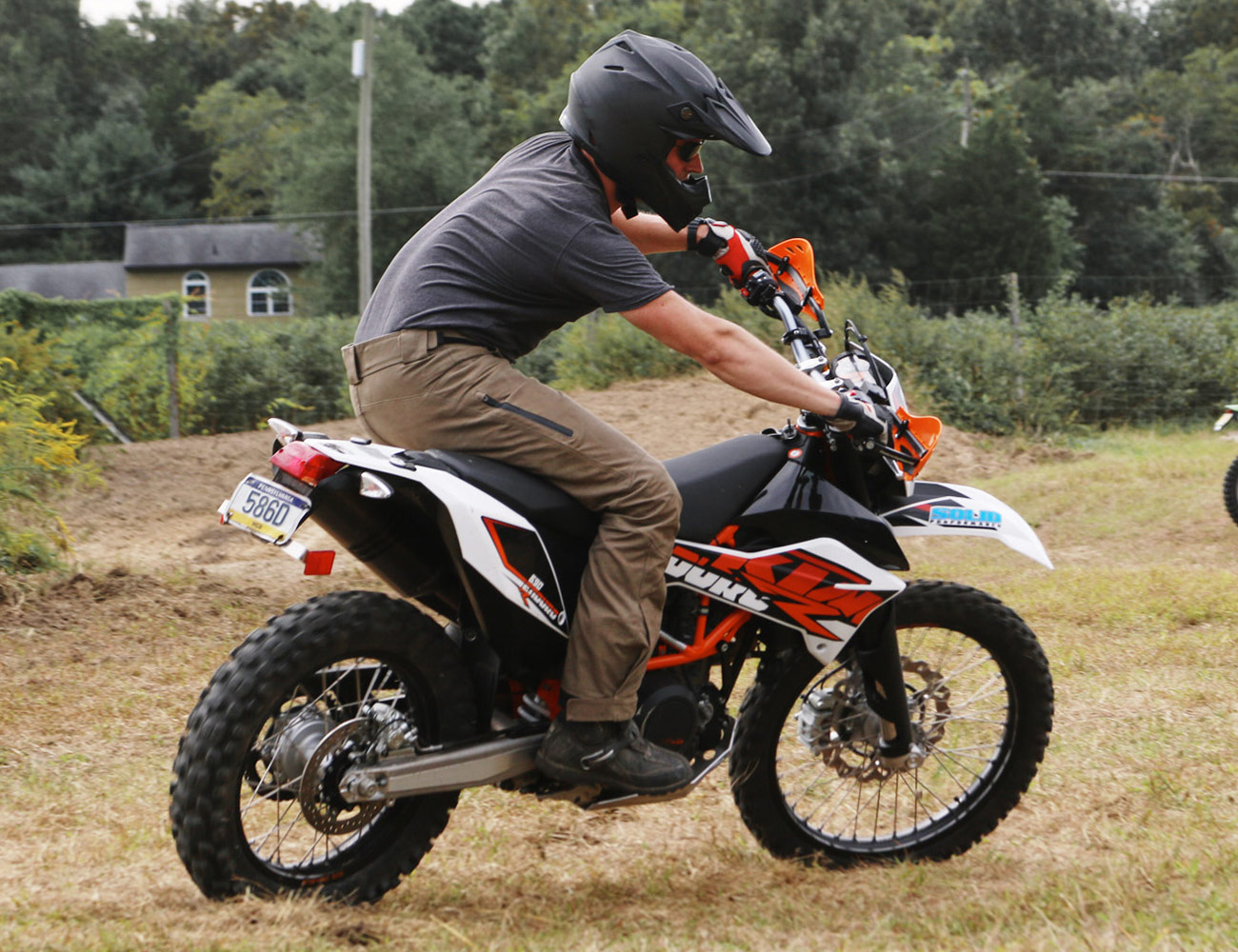I was standing in the middle of a field, in Hammonton, New Jersey, slowly being eaten alive by mosquitoes. An overcast sky intermittently splashed down light rain and “light on the bars, feel it in your feet, light on the bars, feel it in your feet,” calmly repeated in my head between riding exercises. I found myself there, on the edge of Wharton State Forest, by way of an invite from Pine Barrens Adventure Camp Director Jack O’Connor. My goal was to prepare for the upcoming Pine Barrens 500 — a three-day, 500-mile off-road adventure motorcycle ride through New Jersey’s 1.1 million acres of dense forest, deep sand and fire roads filled with blind turns and bike hungry mud pits. The ‘bars and feet’ mantra is PBAC instructor Mike Bradway’s — a 2007 East Coast Enduro Champion, 2000 to 2007 East Coast Enduro Association Top AA rider and veteran of the 400 mile-plus dual sport ride from LA to Barstow to Vegas. So I’m all ears.
Riding off-road isn’t foreign to me at all but, I’ll admit, I still have volumes left to learn. And, since I’ve recently fallen in love with the freedom that is off-road riding, the idea of attending an adventure riding school was high on my list of things to do. Getting out on the trails, cracking the throttle wide open and barreling down fire roads to the tune of a straight-piped single cylinder sounded like a fantastic way to spend a weekend. Bradway’s first exercise? We didn’t even turn on the bikes.
Kickstands up, both feet on the pegs and standing up, we worked on balance in the adventure riding position, seeing how long we could keep the bike up without planting a foot on the ground to catch a fall. My classmates’ bikes ranged from slim Suzuki DRZs and modified Honda XR 650s to a couple of big ol’ BMW R 1200 GSs. Despite having an incredibly light Solid Performance-tuned KTM 690 Enduro tuned by to play with, almost immediately it was obvious my balanced skills sucked — and I hadn’t even clicked the bike into first gear yet. But building up a foundation of simple skills on the bike at a slow pace is crucial because if you rush it and jump up to speed too fast, you’ll fall apart. And when you have trees as thick as streetlight posts grazing inches from your handlebars and varied-traction earth under your tires, you’ll wish you took your time when you had the chance.

The second exercise takes the first and puts it in motion. We fire up our bikes but hardly go near the throttle at all. It’s all about keeping balance and riding “slower than first gear,” as O’Connor put it — feathering the clutch, letting the bike tractor along in a straight line as slow as possible. Not only do you get better acquainted with the action point of the clutch on your own bike, but you learn the motions, or ‘body English’, to keep your bike upright while you inch along.
The next exercise throws a six- or seven foot-long two-by-four into the mix. Aiming to get both wheels on the piece of wood by riding at it longways and then keeping the rear wheel on as long as possible, we were forcing ourselves to learn more skills while putting the previous lesson to work in a new application. Up until the afternoon ride, the rest of the day’s lessons followed the same pattern. From learning what the rear brake feels like when it locks up and when the front does the same to braking and sliding the rear tire into a turn, it was all repetition and basic skill building. That might sound tedious; in practice, it was eye-opening. Not just to how much rudimentary knowledge and motions are put to use on a constant basis while riding, but how much I desperately need the practice.
Almost every exercise was showing me something I had been doing wrong when riding off-road, but the tempo of each lesson and the physical pace at which we were riding around the field made it infinitely easier to recognize the bad habits and then break them. The most important lesson of the day, however, wasn’t a habit to be broken but refining a skill I thought I had a pretty good grasp on: counterbalancing.
“If you stay stiff and try to lean with the bike, you become one giant, top-heavy mass. If you stay loose and nimble, it’s easier to manipulate the bike’s weight.” Bradway explained this concept while monkeying from side to side on his BMW GS with the kickstand down, demonstrating the body movements. Then there it was again, “light on the bars, feel it in the feet.” We practiced slow figure-eights, leaning our bikes into the turns while moving our bodies to the outside, pushing down on the footpegs, keeping relaxed arms, feathering the clutch, alternating from side to side in each turn.
I benefited from having a fairly light bike, which made the exercise a little more manageable. But, when it comes to a BMW R1200 GS, a KTM 1190 Superadventure or any other big adventure bike, counterbalancing is the only hope you have of muscling those behemoths around tight turns, narrow trails or keeping them
from bucking you off in emergency maneuvers.
Throughout the day and out on the trail and during the post-lunch ride, I kept up the repetition. Whenever the group rolled to a stop, I’d slow up, feather the clutch and inch forward, sashaying over the saddle to see how long I could keep my feet off the ground. When we came across murky mud pits in the middle of the trail — not knowing how deep the Jeep tracks running through them went — the only way around was a patch of the trail no wider than the two-by-fours from earlier.

It wasn’t until we arrived at our first sandpit that “light on the bars, feel it in your feet” clicked for me. I’d heard it all day and heard it from other riders before, but I’d never actually forced myself to adhere to the advice when I need it the most.
The tactics and techniques for riding off-road are almost counterintuitive to what you learn riding in the street, especially when it comes to deep sand. You have to go fast enough to keep the front wheel light so that it doesn’t dig in and get a mind of its own, following any rut or track it finds. The handlebars are going to wobble back and forth whether you like it or not, but the moment you accept that’s what they’re going to do and don’t fight it, “light on the bars, feel it in your feet” starts to make an incredible amount of sense.
In deep sand, with your front tire light, skipping across the top of the tiny peaks and valleys, the only way to safely steer the bike is with the footpegs. Counterbalancing and using the throttle and rear wheels like a prop and rudder, riding in the sand is more like manning an old-school jetski than it is a dual sport. It felt like learning a new language at a conversational level.

The second day picked up with more exercises back in the field, continuing to build on each previous lesson by stacking them on top of each other in your memory bank. Reading the trail surface, where to find traction, using ruts for grip and then using counterbalanced turns to get out of them, all while staying light on the bars and feeling the trail through my feet and steering with the pegs.
To be comfortable off-road you have to accept that the front and rear wheel are on a constant search for traction and the bike will dance around underneath you. And you’re definitely going to get dirty. And you’re probably going to lay the bike down. It’s a bit like Indiana Jones taking the leap of faith, but once you make it, riding in the dirt comes much easier. Am I ready for the Pine Barrens 500? We’ll see. I sure as hell am a lot more skilled behind the bars than I was before the PBAC.
Around 11 AM, we set out for a 75-mile trail ride that would last the rest of the day, breaking only for lunch and stops along the trail to point out features and obstacles for even more lessons on how to properly and safely ride trails. Each mile we ticked off was one more where I was practicing and compounding each experience from the past 24 hours. After lunch, it started to rain, but no one on the ride cared — it actually makes for better traction on most of the trails — plus, per O’Connor, “adventure riding is the only sport that extends play time on account of rain.” More practice, more to learn.

